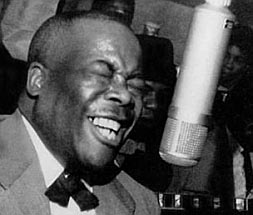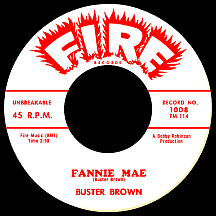BUSTER BROWN
Fannie Mae
In the 1950s, the small town of Cordele in the southern part of Georgia had its own locally-born celebrity, jazz and blues singer Joe Williams (who'd scored a hit twice with "Everyday I Have the Blues," first in '52, then in '55 as "Every Day" with the Count Basie band). Record store owner Bobby Robinson, doing business in New York City since 1946, had indulged in his true passion, producing records, issuing them on his own labels Robin, Red Robin and Whirlin' Disc, all of them soaring, then crashing and burning at separate times in the 1950s. His most successful venture with the Fury and Fire labels, an operation begun in 1957, had by the end of the decade generated exactly one big hit...but what a hit: "Kansas City," the million-selling 1959 smash by Wilbert Harrison. Bobby's next big artist arrived in the form of a 48-year-old part time bluesman from the same wide spot on Georgia's Highway 41 that Joe Williams once called home. And check out his name: Buster Brown, a familiar moniker to most Americans long before he became publicly known for it.
Buster Brown the comic character predated the singer by quite a few years. R.F. Outcault, creator of the Hogan's Alley comic strip of the 1890s and its protagonist the Yellow Kid, introduced his Buster Brown strip in 1902, recounting the adventures of the prank-pulling, pageboy-haircut-wearing Park Avenue youngster and his talking bulldog Tige. Two years into the strip's run in newspapers, Buster and Tige became the mascots for Buster Brown Shoes (Outcault sealed the deal at 1904's historic St. Louis World's Fair, where many still-popular commercial brands came to prominence), "kicking" off a footwear-for-kids brand now into its second century. A number of real-life Buster Browns have emerged in the century since, among them various politicans, sports figures and a popular tap dancer of the '20s and '30s, James "Buster" Brown, who flaunted his fleetness of foot in vaudeville, musical productions on Broadway and as an attraction with, among others, the Cab Calloway and Duke Ellington orchestras; he kept tappin' right up until his death at 88 in 2002.
But let's get back to the Buster Brown at hand. Cordele's blues shouter wasn't particularly motivated to make it big as a musician; he worked as a cab driver for quite a few years and was not adverse to getting his hands dirty as a laborer if need be. The singing and harmonica playing started as a part time endeavor and remained that way from the 1930s through '50s. It's likely he underestimated his own potential, or perhaps didn't care as long as he could whoop it up in his spare time at local clubs. In those days folk festivals were held at the state college in Fort Valley, about 50 miles north of Cordele. Buster sang and blew his harp at one of those events in March 1943, which was recorded as documented in the Library of Congress archives, though titles are unknown; other than this rare example, he made no formal recordings until 1959.
Buster finally got serious about a music career in his late forties, disregarding the fact that nearly every successful singer begins making records in his or her teens or twenties. He moved to New Jersey and found a few small clubs willing to let him perform for tips, doing so at night while making the rounds of independent New York record companies by day. He auditioned for Bobby Robinson, doing an impromptu a cappella/harmonica version of "Fannie Mae," a song he'd written. Bobby imagined how it would sound with a band and called in some of his regular musicians including bassist Jimmy Lewis and guitarists Jimmy Spruill (who'd played on "Kansas City") and Riff Ruffin. The arrangement came together so quickly that Bobby called some horn players and booked time that same night at the Bell Sound Studio; he wanted to catch this lightning in a bottle while the feeling was hot. It took just two takes to get the finished track, a rocking stereo scorcher with Buster's 'Wooos' and a strong harmonica break.

Released in November 1959, the single debuted on Billboard's R&B charts within a few weeks and seemed to peak in the top 20, though after nearly three months in the chart's middle region it still hadn't run its course. Robinson traveled to radio stations around the eastern U.S., determined to get enough of them on board to push "Fannie Mae" into the top ten; meanwhile, the disc slipped into the Hot 100. Surpassing any reasonable expectation, it hit number one on the R&B chart in its 20th week, then bounced into the pop top 40 two weeks later. Brown kept busy making personal appearances during this half-year run; 'Well, I want somebody to tell me what's wrong with me,' he shouted, but of course nothing was wrong. Buster had beaten some real tough odds: he'd become a middle-aged first-time hitmaker!
His album's title, The New King of the Blues, made a bold presumption, though it was appropriate for the moment. The follow-up, "John Henry (The Steel Driving Man)," applied the freshly-minted Brown sound to the 19th century folk tale and artistically it worked, though it managed only a few weeks "Bubbling Under" the charts in May. The next single, a Busterized, 'Wooo'-filled remake of Louis Jordan's more smoothly-delivered 1944 hit "Is You Is or Is You Ain't My Baby," fared better in the fall of '60, though in spite of strong airplay in several big markets (including a top ten peak in Los Angeles), it didn't possess the perseverance of his song about Miss Mae. Other mostly self-composed songs by Buster depended a bit too much on recycling the "Fannie" formula, including the mock-autobiographical "Doctor Brown." "Blues When it Rains," a contrarily happy but welcome track, preceded "Sugar Babe," a crowd-pleaser that placed him back in the R&B top 20 in early 1962.
Leaving Fire Records soon afterwards, he put his stamp on the '20s tune "My Blue Heaven" for the Serock label in early '63. A mostly-spoken tune, "Slow Drag," was one of two singles on Gwenn (the label says it was recorded live in Old Sam Jones' basement, wherever that might be). A brief spell at Chicago's Chess Records yielded one single, "Crawling King Snake," an adjusted take on John Lee Hooker's classic track from '49 set to the tune of Buster's signature hit. Four years passed before "Big Legs - Big Stockings" was recorded in New York and issued on the Nocturn label. Buster Brown passed away in 1976, but not before he brought his recording career full circle with "Fannie Mae's Place," a 1972 single on Astroscope Records...though you could just say he just took one more twirl with his favorite girl.


